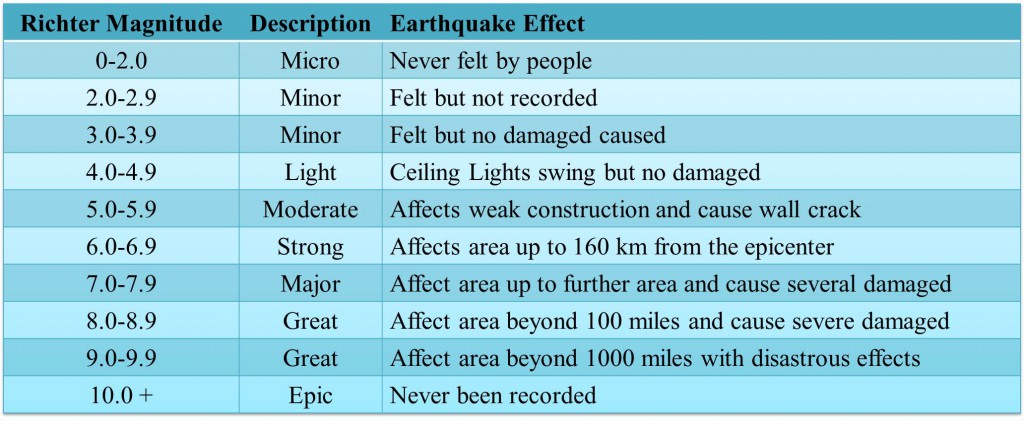
Magnitude (M) is the measure of the energy released by the earthquake, whereas the intensity is what people actually experience. There are two ways to measure earthquakes: magnitude and intensity.

Although the San Francisco earthquake was quite large, most of the damage to the city was actually caused by a fire, which is a common secondary hazard of earthquakes. Looking at the photo, one can visualize how the foreground moved to the left, while the background moved to the right. The fence was once connected, but today it is separated by a 6-meter (20-foot) gap. The Earthquake Trail, which begins at the Bear Valley Visitor Center, follows the trace of the 1906 San Francisco earthquake to a picket fence along the fault ( Figure 10.3). An excellent example of this kind of offset can be found along the San Andreas Fault at Point Reyes National Seashore. The plane defined by the rupture is known as a fault, and the rock layers become offset along it. The rocks then snap apart, releasing energy in the form of seismic waves ( Figure 10.2). According to the elastic rebound theory, rocks can bend elastically up to a point, until they finally break.
RICHTER SCALE AND MOMENT MAGNITUDE SCALE DIFFERENCE FREE
This material is also available as a free iBooks textbook and iTunes U course.Earthquakes occur when a critical amount of stress is applied to the crust. This post is part of Exploring Earthquakes, a rich collection of resources co-presented by the California Academy of Sciences and KQED. Even though earthquakes with moment magnitudes of 5 or 6 can cause damage, in general, only earthquakes with a moment magnitude of 7 or higher are classified as “major” earthquakes.Įarthquake Intensity Maps for the 1906 San Francisco Earthquake Scientists prefer the moment magnitude scale over the Richter scale because it can more accurately compare various types of earthquakes-big or small, near or far-at the same scale. To determine each earthquake’s assigned number, scientists compare the area of the rupture along a fault to the amount of energy released. Its ratings are based on physical evidence, particularly the geometry of the earthquake. This is the scale most scientists use today. In 1979, American scientist Thomas Hanks and Japanese scientist Hiroo Kanamori introduced a new and more precise scale for measuring the magnitude of earthquakes: the moment magnitude scale. Seismographs measure ground motion, including the energy released by an earthquake. Known as the Richter scale, it assigns a number based on the height of the waves on a seismogram (the visual output of a seismograph). To measure the magnitude of an earthquake, the American scientist Charles Richter developed a scale in 1935. Unlike intensity, which varies depending on how populated an area is, the magnitude of an earthquake is the same no matter where you are.

The amount of energy an earthquake releases is expressed in terms of its magnitude. For example, houses built on softer sediments may receive greater damage than those built on bedrock.

The Modified Mercalli number assigned to a particular location varies based on factors such as the distance from the focus and the area’s geology. The higher the Mercalli number is, the more damage found in the area. The 12-point Modified Mercalli Intensity Scale describes how an earthquake is felt and the damage that it causes. A modified version of his scale is still in use today. In 1902, Italian scientist Giuseppe Mercalli introduced a scale that measures the intensity of an earthquake based on its effects on people and structures. Scientists measure both the energy released in an earthquake and its damage.


 0 kommentar(er)
0 kommentar(er)
